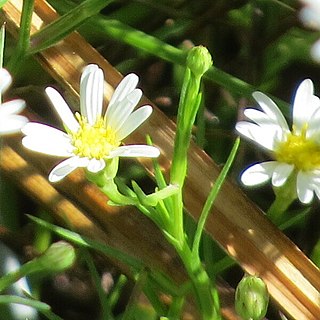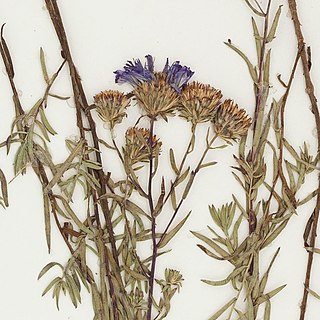
Eriophorum is a genus of flowering plants in the family Cyperaceae, the sedge family. They are found in the cool temperate, alpine, and Arctic regions of the Northern Hemisphere, primarily in the middle latitudes of North America, Europe, and Asia.

Trillium vaseyi is a species of flowering plant in the family Melanthiaceae. It is a spring-flowering perennial plant found only in the southeastern United States. The specific epithet vaseyi honors the American plant collector George Richard Vasey, not to be confused with his father George S. Vasey. The species is commonly called Vasey's Trillium. It is also known as the sweet wakerobin, sweet trillium, or sweet beth.

Rugelia nudicaulis, the sole species of the genus Rugelia, blooms in summer. It is a wildflower endemic to higher elevations in the Great Smoky Mountains. It is a rare species in Tennessee. Genetic diversity in this plant, assessed using allozymes, is so low that the species may not survive changing environmental conditions. Both the scientific name and the common names honor Ferdinand Rugel, a botanist and plant collector who collected plant specimens throughout the southeastern United States during the period 1840–1848.

George S. Vasey was an English-born American physician and botanist. He practiced medicine in Illinois for nearly two decades. He was appointed Chief Botanist at the United States Department of Agriculture in 1872, a position he held for the remainder of his life. His greatest achievement was the building up of the United States National Herbarium.
Eryngium vaseyi is a species of flowering plant in the family Apiaceae. It is endemic to California. The specific epithet vaseyi honors the American plant collector George Richard Vasey who made extensive collections in the region in 1880 and 1881. The species is commonly called Vasey's coyote-thistle.

Hymenachne, synonym Dallwatsonia, is a genus of widespread wetland plants in the grass family Poaceae. They are commonly known as marsh grasses. They are distributed in tropical and subtropical regions of Asia, the Americas, and the Pacific Islands. A species from the Americas, H. amplexicaulis, is well known in other parts of the world as an introduced and invasive species.

Salvia vaseyi, the scallop-leaf sage, bristle sage or wand sage, is a perennial native to the western Colorado Desert. The specific epithet vaseyi honors the American plant collector George Richard Vasey, not to be confused with his father George S. Vasey.

Salvia canescens, the hoary sage, is a herbaceous perennial that is endemic to the Caucasus Mountains. The specific epithet, canescens, refers to the off-white hairs covering the leaves.

Charles Leo Hitchcock was an American botanist. He discovered 20 species of plants and his works have been cited thousands of times. He is also the primary co-author to the Flora of the Pacific Northwest, still the most up to date flora for three northwest U.S. States to date. A hall at the University of Washington is named in his honor, and he taught thousands of botanists over the course of his teaching career at the University of Washington.

Chrysothamnus vaseyi is a species of flowering plant in tribe Astereae in the daisy family Asteraceae. It is native to the Southwestern United States. The specific epithet vaseyi honors the American botanist George S. Vasey. The species is commonly called Vasey's rabbitbrush.
Hymenoxys vaseyi is a species of flowering plant in the daisy family Asteraceae. It is native to the Southwestern United States. The specific epithet vaseyi honors the American plant collector George Richard Vasey who made extensive collections in the region in 1880 and 1881. The species is commonly called Vasey's rubberweed.

Quercus vaseyana is a species of tree in the beech family Fagaceae. It is native to northern Mexico and the U.S. state of Texas. The specific epithet vaseyana honors the American botanist George S. Vasey. The species is commonly called the Vasey oak.

Symphyotrichum patens, commonly known as late purple aster or spreading aster, is a perennial, herbaceous plant found in the eastern United States.

Symphyotrichum potosinum is a species of flowering plant in the family Asteraceae native to Mexico and the U.S. state of Arizona. Commonly known as Santa Rita Mountain aster, it is a perennial, herbaceous plant that may reach heights of 15 to 45 centimeters.

Symphyotrichum eulae is a species of flowering plant in the family Asteraceae endemic to Texas. The common names Eula's aster and Texas aster have been used. It is a perennial, herbaceous plant that may reach 5 to 150 centimeters in height. Its flowers have white to bluish or lavender-white ray florets and yellow then reddish to brown disk florets. It was named for Eula Whitehouse, American botanist, botanical illustrator, and plant collector.

Symphyotrichum turneri is a species of flowering plant in the family Asteraceae native to Durango, Mexico.
Ferdinand Ignatius Xavier Rugel was a German-born American pharmacist, botanist, and plant collector.
George Richard Vasey (1853–1921) was an American plant collector who collected in at least eight U.S. states including California, North Carolina, and Washington. He was the son of Dr. George S. Vasey, a physician and botanist. The botanical activities of father and son overlapped in time, so the two men are often confused.
Juncus vaseyi is a species of flowering plant in the rush family Juncaceae. It is native to North America. The specific epithet vaseyi honors the American botanist George S. Vasey. The species is commonly called Vasey's rush.

Echinopepon rosei is a species of flowering plant in the gourd family Cucurbitaceae.















